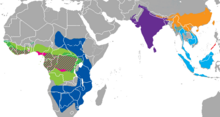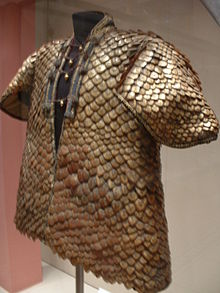Pangolin
| Pangolins[1] Temporal range:
| |
|---|---|

| |
| Sunda pangolin, Manis javanica | |
| Scientific classification | |
| Kingdom: | |
| Phylum: | |
| Class: | |
| Infraclass: | |
| Superorder: | |
| Order: | Pholidota Weber, 1904
|
| Family: | Manidae Gray, 1821
|
| Genus: | Manis Linnaeus, 1758
|
| Species | |
|
Manis culionensis | |

| |
A pangolin (/[invalid input: 'icon']ˈpæŋɡəlɪn/), scaly anteater, or trenggiling, is a mammal of the order Pholidota. The only one extant family (Manidae) has one genus (Manis) of pangolins, comprising eight species. There are also a number of extinct taxa. Pangolins have large keratin scales covering their skin and are the only mammals with this adaptation.[2] They are found in tropical regions of Africa and Asia. The name "pangolin" derives from the Malay word pengguling ("something that rolls up").
Pangolins are nocturnal animals, and use their well-developed sense of smell to find insects. The long-tailed pangolin is also active by day. Pangolins spend most of the daytime sleeping, curled up into a ball.[3]
Classification
Pangolins were classified with various other orders, for example Xenarthra, which includes the ordinary anteaters, sloths, and the similar-looking armadillos. But newer genetic evidence[4] indicates their closest living relatives are the Carnivora, with which they form the clade Ferae.[5] Some paleontologists have classified the pangolins in the order Cimolesta, together with several extinct groups.
Template:Laurasiatheria Cladogram
Physical description and behavior
The physical appearance of pangolins is marked by large, hardened, plate-like scales. The scales, which are soft on newborn pangolins but harden as the animal matures, are made of keratin, the same material of which human fingernails and tetrapod claws are made. The pangolin is often compared to a walking pine cone or globe artichoke. It can curl up into a ball when threatened, with its overlapping scales acting as armour and its face tucked under its tail. The scales are razor-sharp, providing extra defence. The front claws are so long they are unsuited for walking, so the animal walks with its fore paws curled over to protect them. Pangolins can also emit a noxious-smelling acid from glands near the anus, similar to the spray of a skunk. They have short legs, with sharp claws which they use for burrowing into termite and ant mounds, as well as climbing.

The size of pangolins varies by species, ranging from 30 to 100 centimetres (12 to 39 in). Females are generally smaller than males.
The tongues of pangolins are extremely elongated and extend into the abdominal cavity. By convergent evolution, pangolins, the giant anteater, and the tube-lipped nectar bat all have tongues which are unattached to their hyoid bone and extend past their pharynx deep into the thorax.[6] This extension lies between the sternum and the trachea. Large pangolins can extend their tongues as much as 40 centimetres (16 in), with a diameter of only 0.5 centimetres (0.20 in).[3]
Arboreal pangolins live in hollow trees, whereas the ground dwelling species dig tunnels underground, to a depth of 3.5 metres (11 ft).[3] Pangolins are also good swimmers.[3]
Diet

Pangolins lack teeth and the ability to chew. Instead, they tear open anthills or termite mounds with their powerful front claws and probe deep into them with their very long tongues. Pangolins have glands in their chests to lubricate the tongue with sticky, ant-catching saliva.
Some species, such as the tree pangolin, use their strong, prehensile tails to hang from tree branches and strip away bark from the trunk, exposing insect nests inside.
Reproduction
Gestation is 120–150 days. African pangolin females usually give birth to a single offspring at a time, but the Asiatic species can give birth from one to three.[3] Weight at birth is 80–450 g (3–18 ounces), and the scales are initially soft. The young cling to the mother's tail as she moves about, although in burrowing species, they remain in the burrow for the first two to four weeks of life. Weaning takes place at around three months of age, and pangolins become sexually mature at two years.[7]
Threats

Pangolins are hunted and eaten in many parts of Africa, and are one of the more popular types of bush meat. They are also in great demand in China because their meat is considered a delicacy and some Chinese believe pangolin scales have medicinal qualities. This, coupled with deforestation, has led to a large decrease in the numbers of giant pangolins. In November 2010, pangolins were added to the Zoological Society of London's list of genetically distinct and endangered mammals.[8]
Pangolin populations have suffered from illegal trafficking. In May 2007, for example, 31 pangolins were found aboard an abandoned vessel off the coast of China. The boat contained some 5,000 endangered animals.[9]
The Guardian provided a description of the killing and eating of pangolins: "A Guangdong chef interviewed last year in the Beijing Science and Technology Daily described how to cook a pangolin: 'We keep them alive in cages until the customer makes an order. Then we hammer them unconscious, cut their throats and drain the blood. It is a slow death. We then boil them to remove the scales. We cut the meat into small pieces and use it to make a number of dishes, including braised meat and soup. Usually the customers take the blood home with them afterwards.'"[9]
Taxonomy

- ORDER PHOLIDOTA
- Family †Epoicotheriidae
- Family †Metacheiromyidae
- Family Manidae
- Subfamily †Eurotamanduinae
- Genus †Eurotamandua
- Subfamily Maninae
- Genus †Cryptomanis
- Genus †Eomanis
- Genus †Necromanis
- Genus †Patriomanis
- Genus Manis
- Subgenus Manis
- Indian pangolin (M. crassicaudata)
- Chinese pangolin (M. pentadactyla)
- Asian giant pangolin (M. paleojavanica) †
- Subgenus Paramanis
- Sunda pangolin (M. javanica)
- Philippine pangolin (M. culionensis)
- Subgenus Smutsia
- Giant pangolin (M. gigantea)
- Ground pangolin (M. temmincki)
- Subgenus Phataginus
- Tree pangolin (M. tricuspis)
- Subgenus Uromanis
- Long-tailed pangolin (M. tetradactyla)
- Subgenus Manis
- Subfamily †Eurotamanduinae
Fun trivia
In April 26, 2012 Canonical Ltd., a software company, released their "Precise Pangolin" a long term support version of Ubuntu, a Linux based operating system[10].
References
- ^ Schlitter, D.A. (2005). Wilson, D.E.; Reeder, D.M. (eds.). Mammal Species of the World: A Taxonomic and Geographic Reference (3rd ed.). Johns Hopkins University Press. pp. 530–531. ISBN 978-0-8018-8221-0. OCLC 62265494.
- ^ The Encyclopedia of World Wildlife. Paragon Books. 2006. p. 63.
{{cite book}}: Unknown parameter|writer=ignored (help) - ^ a b c d e Mondadori, Arnoldo Ed., ed. (1988). Great Book of the Animal Kingdom. New York: Arch Cape Press. p. 252.
- ^ Murphy; Willian J.; et al. (2001-12-14). "Resolution of the Early Placental Mammal Radiation Using Bayesian Phylogenetics". Science. 294 (5550): 2348–2351. doi:10.1126/science.1067179. PMID 11743200.
{{cite journal}}: Unknown parameter|author-separator=ignored (help) - ^ BioMed Central | Full text | A higher-level MRP supertree of placental mammals
- ^ Chan, Lap-Ki (1995). "Extrinsic Lingual Musculature of Two Pangolins (Pholidota: Manidae)". Journal of Mammalogy. 76 (2). Journal of Mammalogy, Vol. 76, No. 2: 472–480. doi:10.2307/1382356. JSTOR 1382356.
- ^ Dickman, Christopher R. (1984). Macdonald, D. (ed.). The Encyclopedia of Mammals. New York: Facts on File. pp. 780–781. ISBN 0-87196-871-1.
- ^ 'Asian unicorn' and scaly anteater make endangered list
- ^ a b Watts, Johnathan (20007). "'Noah's Ark' of 5,000 rare animals found floating off the coast of China". The Guardian. Retrieved 13 August 2011.
{{cite news}}: Check date values in:|year=(help); Unknown parameter|month=ignored (help)CS1 maint: year (link) - ^ http://www.itworldcanada.com/news/ubuntu-linux-12-04-precise-pangolin-is-here-at-last/145323
